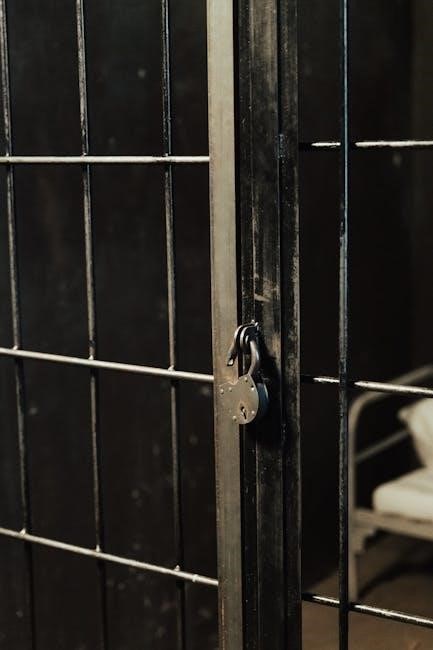Overview of the Book
1.1 Authors and Edition Details
1.2 Key Features of the 5th Edition
1.3 Publisher and Publication Information

Structure of the Book
The book is organized into chapters, each focusing on specific aspects of criminal justice, with learning objectives, activities, and visual elements to enhance understanding and engagement.
2.1 Chapter Breakdown
2.2 Learning Objectives and Activities
The 5th edition incorporates clear learning objectives and engaging activities to enhance student understanding. Each chapter includes “learn-by-doing” exercises that promote critical thinking and practical application. These activities encourage students to analyze real-world scenarios, fostering a deeper grasp of criminal justice processes. The book’s problem-based approach ensures students can apply theoretical concepts to actual cases, bridging the gap between academia and practice. This interactive learning model prepares students for careers in criminal justice by developing their analytical and decision-making skills.

2.3 Visual and Interactive Elements
The 5th edition features engaging visual and interactive elements to enhance learning. Flowcharts, infographics, and photographs illustrate key concepts and processes, making complex topics more accessible. Interactive activities, such as quizzes and scenario-based exercises, are included to reinforce understanding. The book also provides access to a companion website with multimedia tools, including videos and case studies, to deepen engagement and offer a dynamic learning experience. These elements make the material more engaging and easier to digest for students.

Criminal Justice System Basics
The book provides a foundational understanding of the criminal justice system’s operations, emphasizing the importance of understanding its intricate workings from investigation to sentencing and key principles.
The criminal justice system is a network of institutions and practices dedicated to maintaining social order. The 5th edition provides a clear, concise introduction, suitable for both students and professionals. It bridges theory and practice, offering insights into the system’s foundational elements, including law enforcement, legal processes, and corrections. Ethical considerations are emphasized, ensuring a well-rounded understanding. Real-world case studies illustrate key concepts, making abstract ideas relatable. This section serves as a robust foundation for exploring the complexities of criminal justice.
3.2 The Process: Investigation to Sentencing
The criminal justice process begins with investigation, where law enforcement gathers evidence to identify suspects. Prosecutors then review cases to determine if charges should be filed. If indicted, defendants proceed to trial, where guilt or innocence is determined. Sentencing follows, outlining penalties for the convicted. This structured flow ensures accountability and fairness. The 5th edition provides detailed insights into each phase, using interactive activities and real-world examples to illustrate how the system operates in practice, ensuring students grasp the complexities of the process.
3.3 Roles of Key Components: Police, Courts, Corrections
The police enforce laws and investigate crimes, serving as the first point of contact in the justice system. Courts adjudicate cases, ensuring due process and determining guilt or innocence. Corrections manages punishment and rehabilitation, overseeing jails, prisons, and parole systems. Each component plays a vital role in maintaining public safety and upholding justice. The 5th edition highlights their interdependence, using real-world examples to illustrate how these elements work together to achieve systemic goals and balance individual rights with societal needs. This integrated approach provides a comprehensive understanding of their functions.

Ethical Considerations
The book examines ethical challenges within the criminal justice system, emphasizing the importance of moral principles in decision-making and their practical application in real-world scenarios.
4.1 Ethical Issues in Practice
The 5th edition explores real-world ethical dilemmas faced by criminal justice professionals, emphasizing the application of moral principles in daily practices. It delves into issues such as police conduct, court decisions, and correctional policies, providing a framework for resolving ethical conflicts. The text highlights the importance of ethical awareness in maintaining public trust and ensuring justice. By examining case studies, students learn to critically evaluate situations and apply ethical reasoning to practical scenarios. This section underscores the necessity of integrity in criminal justice operations.
4.2 Ethical Dilemmas in Criminal Justice
The 5th edition delves into real-world ethical dilemmas, presenting scenarios that challenge criminal justice professionals. It explores moral conflicts in policing, such as use of force, and judicial decisions, like sentencing disparities. The text examines how professionals navigate these issues, emphasizing the role of discretion and accountability. Through case studies, students analyze dilemmas like racial bias and technological impacts on justice. This section equips readers with tools to evaluate and address ethical challenges, fostering a deeper understanding of justice and morality in practice.
4.3 The Role of Ethics in Decision-Making
The 5th edition emphasizes the critical role of ethics in shaping decisions within the criminal justice system. It highlights how ethical principles guide professionals in policing, courts, and corrections, ensuring fairness and accountability. The text provides practical tools for resolving moral conflicts and applying ethical frameworks in real-world scenarios. By fostering a deep understanding of ethical decision-making, the book prepares students to navigate complex situations with integrity, balancing justice and individual rights in their future careers. This focus ensures ethical practices remain central to criminal justice operations.

Practical Application
The 5th edition integrates problem-based learning and real-world case studies to bridge theory and practice, enabling students to apply criminal justice concepts to actual scenarios effectively.
5.1 Problem-Based Learning Approach
The 5th edition employs a problem-based learning approach, encouraging students to engage with real-world scenarios and ethical dilemmas. This method fosters critical thinking and practical application of criminal justice concepts. By presenting actual cases, the text helps students develop analytical skills and understand the complexities of the criminal justice system. Interactive activities and exercises are integrated to enhance learning, making the material relatable and applicable to future careers in the field. This approach ensures students are well-prepared to address challenges in criminal justice practice.
5.2 Real-World Case Studies
The 5th edition incorporates real-world case studies to provide practical insights into criminal justice processes. These studies cover a range of scenarios, from investigations to sentencing, offering students a deeper understanding of real-life applications. By analyzing these cases, learners can identify procedural challenges, policy implications, and ethical dilemmas. The text includes current and relevant examples, ensuring students are prepared to address modern issues in law enforcement, courts, and corrections. This approach bridges theory and practice, enhancing critical thinking and decision-making skills.
5.3 Engaging Activities for Critical Thinking
The 5th edition includes engaging activities designed to foster critical thinking and hands-on learning. These activities, such as scenario-based exercises and problem-solving tasks, encourage students to apply theoretical concepts to real-world challenges. Learners analyze case studies, debate ethical dilemmas, and develop strategies for improving criminal justice processes. These interactive elements help students connect theory with practice, preparing them for professional roles. The activities are structured to enhance collaboration, creativity, and decision-making skills, ensuring a comprehensive understanding of the criminal justice system.

Recent Developments and Trends
The 5th edition highlights emerging trends in criminal justice, including technology integration, ethical considerations, and modern investigative techniques. It emphasizes real-world applications and updates on current issues.
6.1 Updates in the 5th Edition
6.2 Emerging Issues in Criminal Justice
The book highlights emerging issues such as technology’s role in investigations, ethical dilemmas in policing, and the impact of wrongful convictions. It addresses contemporary challenges like criminal justice reform, racial disparities, and the opioid crisis. The 5th edition also explores innovative approaches to rehabilitation and alternative sentencing, providing insights into modern criminal justice practices. These topics prepare students to engage with the evolving nature of the field and its real-world implications.
6.4 Technology’s Impact on Criminal Justice
The 5th edition explores how technology transforms criminal justice, from digital evidence collection to surveillance tools and data analytics. It discusses the role of facial recognition, crime mapping, and predictive policing in modern law enforcement. The text also examines ethical concerns surrounding privacy and algorithmic bias in criminal justice systems. By addressing these advancements, the book prepares students to navigate the evolving intersection of technology and justice;

Supplementary Resources
The 5th edition offers a PDF version for easy access, along with a companion website featuring interactive tools and bibliographical references for further reading.
7.1 Availability of PDF Version
7.2 Companion Websites and Tools
7.3 Bibliographical References and Further Reading

Importance in Criminal Justice Education
8.1 Role in Academic Curricula




